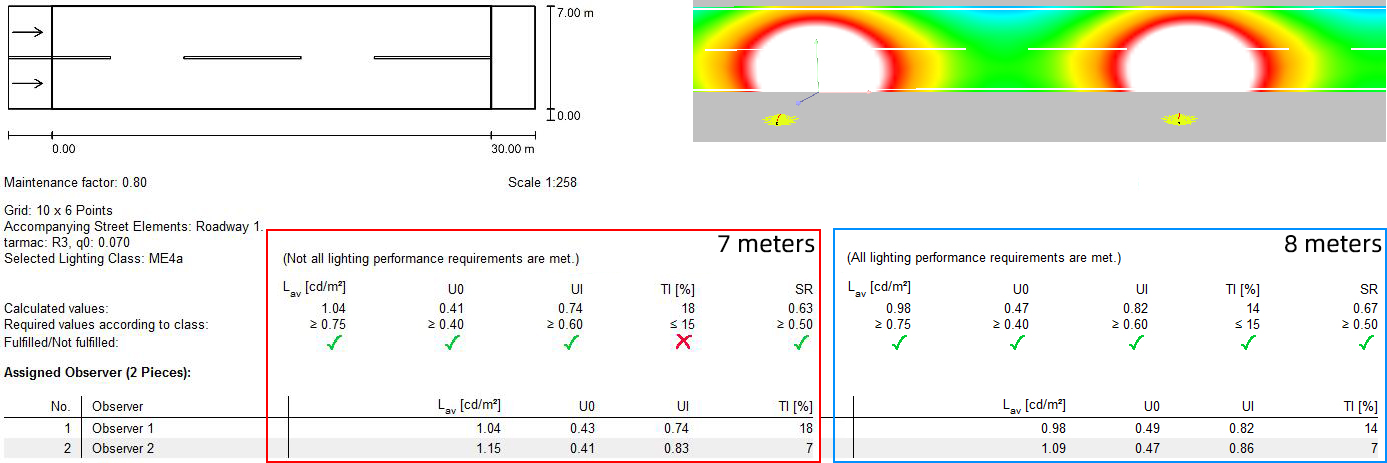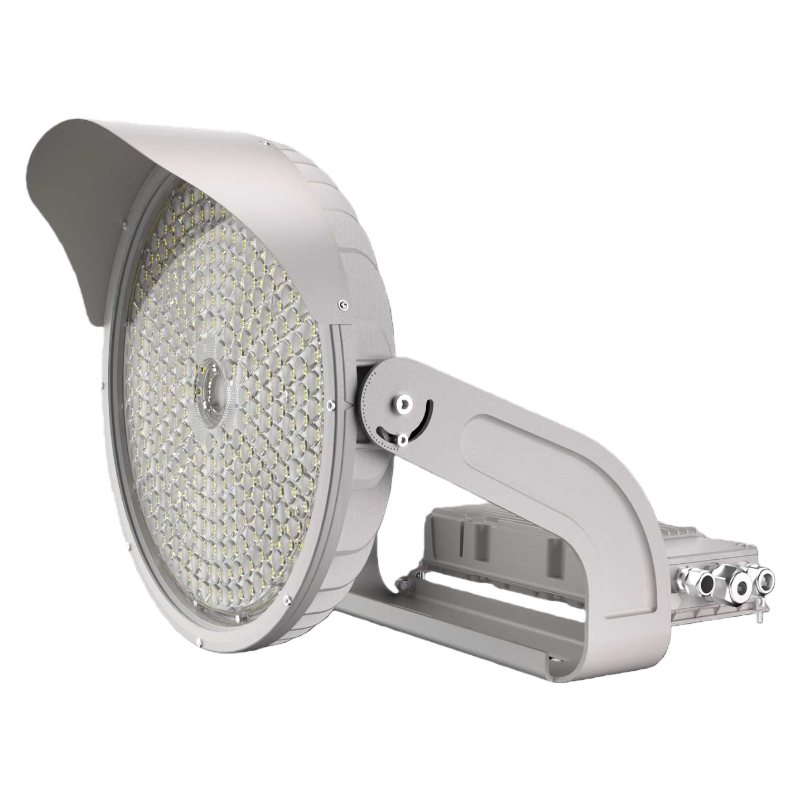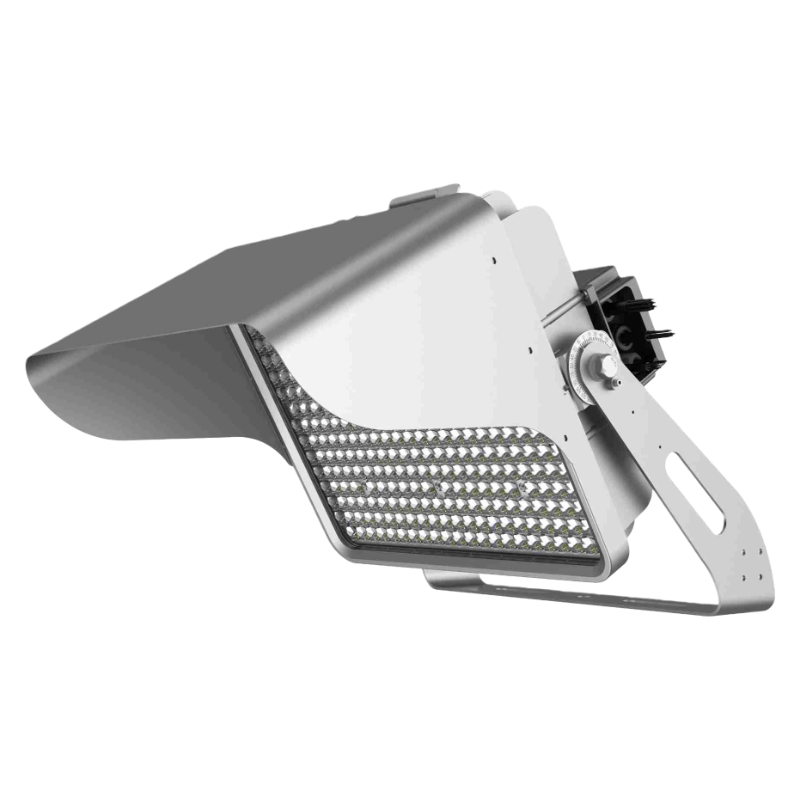Reduce glare – UGR, GR and Ti in lighting design
Introduction
Glare, including disability glare and discomfort glare, has a significant impact on people’s visual perception, psychological state, and quality of life. Disability glare poses a safety hazard by reducing the visibility of objects and damaging eye health; while discomfort glare causes psychological discomfort and affects mood and quality of life. To mitigate these hazards, we need to optimize the lighting environment and protect visual health by adjusting the position and light distribution of lamps and using light shields/hoods. This article mainly introduces what’s UGR, GR, and TI, and their calculation methods. In addition, we will also introduce how to check and improve the glare (reduce glare) of stadium lighting and the glare (TI) of road lighting.

What are UGR, GR, and TI?
Glare can be divided into two categories: disability glare and discomfort glare. Disability glare is reduced visibility due to scattered light in the eye, and is commonly seen with car headlights. It is not necessarily associated with physical discomfort, just reduced visibility. Disability glare tests measure a subject’s ability to detect objects in the presence of a glare source. In contrast, discomfort glare is defined as an annoying or painful sensation when exposed to bright light in the field of vision, but does not necessarily impair vision. Discussions of glare in sports lighting generally refer to the discomfort type of glare. Unlike disability glare, discomfort glare is subjective. There are many different models and variables used to quantify discomfort glare.
The measurement of glare is based on the measurement of light, so before discussing glare further, it is important to understand some basics of measuring light. The intensity of light or a light source is quantified using illuminance and brightness. Illuminance is the amount of light (luminous flux) incident on a surface or area, basically how much light enters an area, and it is measured in lux (lumensper square meter). While illuminance quantifies the light shining on an area, luminance by contrast quantifies the light emitted from an area. Luminance is the measurement of the intensity of light emitted from a specific area within a solid angle (luminous intensity), and it is measured in candela per square meter. Below we introduce the common UGR, GR and Ti.
UGR
UGR is the abbreviation of Unified Glare Rating. It is a psychological parameter that measures the subjective discomfort caused by the light emitted by the lighting device in the visual environment to the human eye. Its value can be calculated according to the unified glare formula published by the International Commission on Illumination. Application scenario: UGR is often used to evaluate the degree of uncomfortable glare in classrooms, offices, and other places.
GR
GR is the abbreviation of Glare rating, which represents the glare level of a lighting place and is used to evaluate the glare discomfort caused by lighting devices. UGR focuses specifically on indoor lighting, while GR focuses primarily on outdoor lighting. In sports lighting, glare can significantly affect the performance and comfort of athletes and the experience of spectators. Reasonable control of the value of GR is crucial to ensure visibility on the court and reduce visual discomfort.
Ti
TI, or threshold increment, is a measurement method to describe disabling glare. It represents the percentage of contrast between an object and its background that we need to increase in order to maintain visual perception (i.e., recognition) of an object in the presence of glare. In other words, if there is no glare, we may only need a lower contrast (low TI value) to see the object clearly; but once glare appears, in order to continue to see the object clearly, we need to increase the contrast between the object and the background.
| UGR | GR | Ti | |
| Meaning | Unified Glare Rating | Glare Rating | Threshold Increment |
| Application | Indoor lighting | Outdoor(sports lighting) | Street lighting |
| Formula |
How to calculate UGR, GR and Ti?
UGR
The formula includes background brightness (LB), luminaire brightness (L), the solid angle between the light source and the observer (ω), and the Gus position index (р). Here we can simply think of Lb as the indirect illumination in the direction of the eye, which includes the lighting intensity of the wall, ceiling, ground, etc. The second half of the formula can be thought of as the brightness generated by the luminaire, and it is also related to the position of the luminaire.
Simplified, UGR = brightness generated by the lamp / indirect illumination in the direction of the eye. Generally speaking, the greater the luminous flux of the lamp, the lower the installation height, the larger the beam angle, the smaller the luminous surface, and the lower the indoor wall/floor reflectivity, the greater the glare it produces. In addition, glare is also affected by the installation position of the lamp, whether the light source is blocked/diffused, and the light distribution characteristics of the lamp.
GR
Glare Rating (GR) – This model was developed by the International Commission on Illumination (CIE) for outdoor lighting, referring to CIE document 112-1994. The glare rating is calculated based on the illuminance at the eye when observing each point in the array of points from a single observer position. In the following formula, Lvl is the illuminance generated by the light emitted by the lamp directly hitting the eye. Lve can be understood as the illuminance caused by the environment directly hitting the eye, that is, the brightness of the illuminated site.
After simplification, GR = brightness generated by the lamp/brightness of the illuminated site. In general, increasing the installation height, using sunshades, and using asymmetric light distribution can effectively reduce the value of GR.
TI
TI is a measure of the effect of disability glare, described as an equivalent veiling luminance caused by scattering of light in the human eye. TI values are calculated in accordance with EN 13201-3 by means of an equation for the equivalent veiling luminance which represents a young person. When setting requirements for the limitation of the TI, or when evaluating calculated TI values, it should be taken into account that the scattering in the eye tends to increase with the age of the person. The definition in CIE 150:2017 is similar. The formula for calculating TI in these two documents is: TI = 65 Lv /( Lad)0.8, where Lv = veiling luminance and Lad = adaptation luminance
PS: In this formula, adaptation luminance is the sum of the veiling luminance from the scene and the background luminance. So it differs from average roadway luminance. Please review case studies of LED roadway lights.
Main principles to reduce glare in lighting
After understanding the calculation method of glare, we probably have a certain understanding of how to reduce glare. ZGSM believes that we should start from two aspects: the direction of light and the installation of lamps.
First, let’s talk about the direction of light. This is like the lamp in your home. If it is not designed well, the light will be scattered, not only illuminating the place you want to illuminate, but also running to the place you don’t want it to go, such as your eyes. At this time, you will feel glare. In order to solve this problem, lamp designers or manufacturers will work hard on lamps, such as adding lightshades, reflectors or special lenses, which is like adding sights to lamps, so that they only shine where they should go, instead of directly into the eyes.
Then let’s talk about the installation of lamps. In practical applications, the installation of lamps is also critical. Imagine if you look up on the playground, a lamp on a high pole and a lamp on a low pole, which one is less likely to make you feel glare? Of course, the short one. Because the high lamp is far away from you, the light becomes soft when it reaches you, and it is not easy to produce glare. Therefore, generally speaking, the higher the lamp is installed and the closer it is to the target area, the less likely it is to make people feel uncomfortable. However, if the position of the lamp cannot be moved, we can also try to align the center point of the lamp with a place close to the installation position, which can also reduce glare. However, there will be a problem at this time: we must reduce glare while ensuring that the target area has sufficient lighting. Therefore, we need to make reasonable choices in the installation height and the direction of illumination. For example, a high and as horizontal as possible luminous surface is often comfortable, but the cost is also high. The solution with a low installation height and a large elevation angle of the luminous surface often has higher glare, but its cost is lower. This requires lighting designers to balance the economy and comfort of lighting. When designing and installing lamps, they often need to consider various factors according to the actual situation to find the best solution. Let us explain them one by one as follows.
GR in sports lighting, TI in street lighting and how to improve them?
GR in sports lighting
In sports lighting, glare can significantly affect the performance and comfort of athletes and the experience of spectators. Different sports activities and spaces have specific GR requirements that need to be met to ensure optimal lighting conditions. Many outdoor competition venues have a maximum glare of 50, training venues have a maximum glare of 55, and the evaluation height is often 1.5 meters above the ground. In stadium lighting, we need to measure the GR value of various points in the stadium. The observer position, viewing angle, luminaire light distribution, and recommended thresholds are taken into account during the evaluation process. In the stadium lighting simulation, we need to insert a glare observer to obtain the glare value. The figure below shows the glare calculation results for a 105 x 68-meter football field. In this lighting simulation, all glare points are 50 in below the calculation surface. In the next section, we will discuss how to reduce these values.
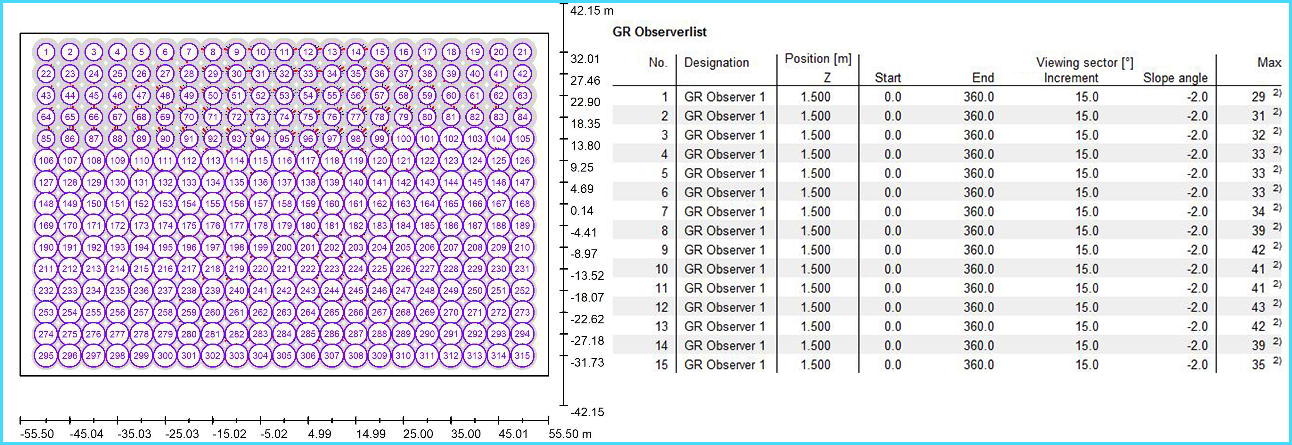
TI in street lighting
TI stands for Threshold Increment, a measure used in street lighting to quantify the impact of glare on visual tasks such as driving. In road lighting, motor vehicle lanes have clear requirements for TI values. M lighting classes, which from M1 to M6, require the TI 10-20%. For example, TI for M4a road lighting systems is lower than 15%. High TI values indicate higher levels of glare and reduced visibility, which can be dangerous for drivers. In the new section, we can find TIs in road lighting simulations. Some of them can meet the requirements, while others can not. What we need to do is how to adjust to meet the corresponding requirements, which we will introduce in detail below.
Standard light distribution vs light distribution with shield or hood
Glare protection, also known as visors or shields, is an essential accessory for outdoor lighting installations. Without anti glare measures such as light shield, the light emitted by the light source may directly hit people’s eyes, causing glare. On the contrary, the addition of light shield is to minimize glare and light pollution by blocking direct light from hitting pedestrians’ eyes, thereby improving visual comfort and productivity. As follows, we analyze the two situations of stadium lighting without and with light shield. In the left figure, we can see that ULR=6.5%, and its glare is also high, reaching a maximum of 47. After using the light shield, we can see that ULR=1.0%, and its glare is also effectively controlled, reaching a maximum of 44. At the same time, we can see that the former will have a higher illuminance, while the latter will have a lower illuminance, mainly because the light shield blocks part of the useful light.
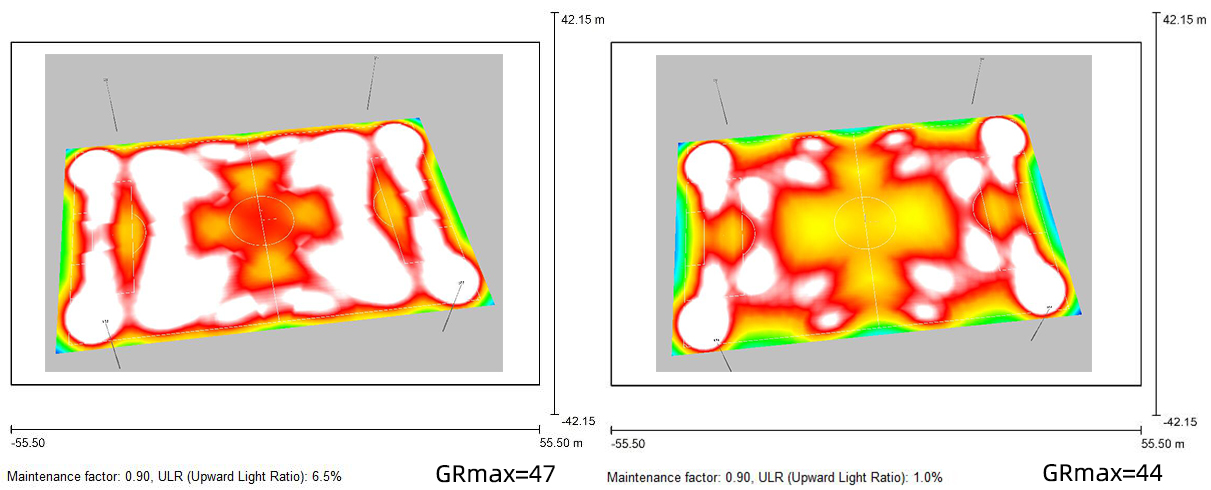
Standard light distribution vs asymmetric
Asymmetric light distribution highlights the concentration of light in a specific direction without dissipating it in any direction. It can be achieved through lenses or mirrors. Therefore, it minimizes the distribution of light in unnecessary spaces and helps reduce light pollution. The best examples of asymmetric lighting are street lights, stadium and parking lot lighting, etc. Additionally, asymmetric spectra have greater potential for glare reduction. By rationally designing the luminous angle and light intensity distribution of the light source, glare can be significantly reduced and lighting quality improved. Below we compare the lighting results of using symmetrical light distribution and asymmetrical light distribution in stadium lighting. In the picture on the right below, we can see that with ULR=0%, the maximum glare value has been reduced to 39. Using symmetrical light distribution, the results are not unsatisfactory. You can refer to the results in the previous section. In addition, the use of asymmetric light distribution and hood also has a certain impact on the light efficiency of the lamp. We need to consider GR comprehensively and cost before making a final choice.
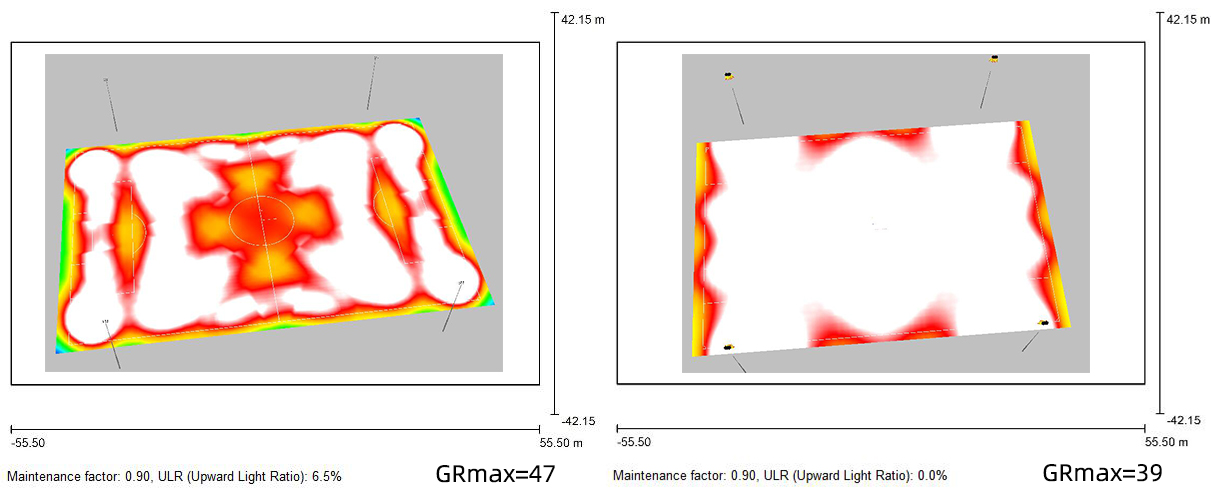
Right installation height to reduce glare
The installation height of the lamp is one of the important factors affecting glare. When the installation height of the street lamp is too low, the light will directly shine into the human eye, causing glare. On the contrary, when the installation height is high, the proportion of the lamp light directly shining into the eye will be reduced. Therefore, choosing the right installation height is crucial to reducing glare. Let’s analyze the impact of different installation heights on the Ti of road lighting. The installation height of the street light on the left is 7 meters, and the TI value reaches 18, but when we increase the height to 8 meters, the Ti value drops to 14. When the height cannot be adjusted, we can also reduce the Ti value by replacing the light distribution.
PS: In the stadium lighting, we can appropriately increase the installation height and reduce the GR value.
